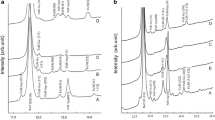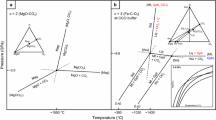Abstract
A reconnaissance investigation has been carried out on melting relationships in the system Fe-FeO at pressures up to 25 GPa and temperatures up to 2200° C using an MA-8 apparatus. Limited studies were also made of the Co-CoO and Ni-NiO systems. In the system FeFeO, the rapid exsolution of FeO from liquids during quenching causes some difficulties in interpretation of textures and phase relationships. The Co-CoO and Ni-NiO systems are more tractable experimentally and provide useful analogues to the Fe-FeO system. It was found that the broad field of liquid immiscibility present at ambient pressure in the Co-CoO system had disappeared at 18 GPa, 2200° C and that the system displayed complete miscibility between molten Co and CoO, analogous to the behaviour of the Ni-NiO system at ambient pressure. The phase diagram of the system Fe-FeO at 16 GPa and from 1600–2200° C was constructed from interpretations based on the textures of quenched run products. The solubility of FeO in molten iron is considerably enhanced by high pressures. At 16 GPa, the Fe-FeO eutectic contains about 10–15 mol percent FeO and the eutectic temperature in this iron-rich region of the system occurs at 1700±25° C, some 350° C below the melting point of pure iron at the same pressure. The solubility of FeO in molten Fe increases rapidly as temperature increases from 1700 to 2200° C. A relatively small liquid immiscibility field is present above 1900° C but is believed to be eliminated above 2200° C. This inference is supported by thermodynamic calculations on the positions of key phase boundaries. A single run carried out on an Fe50 FeO50 composition at 25 GPa and 2200° C demonstrated extensive and probably complete miscibility between Fe and FeO liquids under these conditions.
The melting point of iron is decreased considerably by solution of FeO at high pressures; moreover, the melting point gradient (dP/dT) of the Fe-FeO eutectic is much smaller than that of pure iron and is also smaller than that of mantle pyrolite under the P, T conditions studied. These characteristics make it possible for melting of metal phase and segregation of the core to proceed within the Earth under conditions where most of the mantle remains below solidus temperatures. Under these conditions, the core would inevitably contain a large proportion of dissolved FeO. It is concluded therefore, that oxygen is likely to be the principal light element in the core. The inner core may not be composed of pure iron, as often proposed. Instead, it may consist of a crystalline oxide solid solution (Ni, Fe)2O.
Similar content being viewed by others
References
Birch F (1964) Density and composition of mantle and core. J Geophys Res 69:4377–4388
Boehler R (1986) The phase diagram of iron to 430 kbar. Geophys Res Lett 13:1153–1156
Dubrovskiy VA, Pan'kov V (1972) On the composition of the earth's core Izv. Phys Solid Earth 7:48–54
Elsasser WM (1963) Early history of the earth. In: Geiss J, Goldberg E (eds) Earth science and meteorites, North Holland, Amsterdam, pp 1–30
Fischer WA, Schumacher JF (1978) Die Sättigungslöslichkeit von Reineisen an Sauerstoff vom Schmelzpunkt bis 2046° C, ermittelt mit dem Schwebeschmelzverfahren. Arch Eisenhüttenwes 49:431–435
Getting IC, Kennedy GC (1970) Effect of pressure on the e.m.f. of chromel-alumel and platinum-platinum, 10% rhodium thermocouples. J Appl Phys 41:4552–4562
Hansen M, Anderko K (1958) Constitution of binary alloys. McGraw Hill, New York
Heinz DL, Jeanloz R (1987) Measurement of the melting curve of Mg0.9Fe0.1SiO3 at lower mantle conditions and its geophysical implications. J Geophys Res 92:11437–11444
Irifune T, Hibberson WO (1985) Improved furnace design for multiple anvil apparatus for pressures up to 18 GPa and temperatures to 2000° C. High Temp High Press 17:575–579
Jeanloz R, Ahrens T (1980) Equation of state of FeO and CaO. Geophys JR Astron Soc 62:505–528
Jephcoat AP, Olson P (1987) Is the inner core of the earth pure iron? Nature 325:332–335
Kato M (1985) Melting experiment on Fe-FeO-FeS system up to 20 GPa and its significance on the formation and composition of the earth's core. PhD Thesis, Nagoya University
Kato T, Kumazawa M (1985) Effect of high pressure on the melting relation in the system Mg2SiO4: Part I Eutectic relation up to 7 GPa. J Phys Earth 33:513–524
Kato T, Kumazawa M (1986) Melting and phase relations in the system Mg2SiO4-MgSiO3 at 20 GPa under hydrous conditions. J Geophys Res 91:9351–9355
Kato T, Ringwood AE, Irifune T (1988a) Experimental determination of element partitioning between silicate perovskites, garnets and liquids: Constraints on early differentiation of the mantle. Earth Planet Sci Lett 89:123–145
Kato T, Ringwood AE, Irifune T (1988b) Constraints on element partition coefficients between MgSiO3 perovskite and liquid determined by direct measurements. Earth Planet Sci Lett 90:65–68
Knittle E, Jeanloz R (1986) High pressure metallization of FeO and implications for the Earth's core. Geophys Res Lett 8:1541–1544
Lindsley DH (1966) Pressure-temperature relations in the system FeO-SiO2. Ann Rept Geophys Lab 65:226–230
Liu LG, Bassett WA (1975) The melting of iron up to 200 kb. J Geophys Res 80:3777–3782
McCammon CA, Ringwood AE, Jackson I (1983) Thermodynamics of the system Fe-FeO-MgO at high pressure and temperature and a model for formation of the Earth's core. Geophys J R Astrom Soc 72:577–595
Murthy VR, Hall H (1970) The chemical composition of the Earth's core: Possibility of sulfur in the core. Phys Earth Planet Inter 2:276–282
Ohtani E, Ringwood AE (1984) Composition of the core, I. Solubility of oxygen in molten iron at high temperatures. Earth Planet Sci Lett 71:85–93
Ohtani E, Ringwood AE, Hibberson WO (1984) Composition of the core, II. Effect of high pressure on solubility of FeO in molten iron. Earth Planet Sci Lett 71:94–103
Ohtani E, Ringwood AE, Major A, Hibberson WO (1984) Solubilities of NiO and CoO in molten nickel and cobalt. (Unpublished experimental results and manuscript)
Ohtani E, Irifune T, Ringwood AE, Hibberson WO (1987) Modified split-sphere guideblock for practical operation of a multiple-anvil. High Temp High Press 19:523–529
Ringwood AE (1959) On the chemical evolution and densities of the planets. Geochim Cosmochim Acta 15:257–283
Ringwood AE (1977) Composition of the core and implications for the origin of the earth. Geochem J 11:111–135
Ringwood AE (1984) The Earth's core: its composition, formation and bearing upon the origin of the Earth. Proc R Soc London A 395:1–46
Ringwood AE, Major A (1982) Mutual solubilities of molten transition metals and oxides. Lunar Planet Sci XIII Part 2:651–652
Safronov VS (1978) Evolution of the protoplanetary cloud and formation of the Earth and planets, Translated from the Russian, Israel Program for Scientific Translations. Tel Aviv
Sterrett KF, Klement W, Kennedy GC (1965) Effect of pressure on the melting of iron. J Geophys Res 70:1979–1984
Stevenson DJ (1981) Models of the earth's core. Science 214:611–619
Tankens ES, Gokcen NA, Belton GR (1964) The activity and solubility of oxygen in liquid iron, nickel and cobalt. Trans Metallurgical Soc AIME 230:820–827
Urakawa S, Kato M, Kumazawa (1987) Experimental study on the phase relations in the system Fe-Ni-O-S up to 15 GPa. In: Manghnani MH, Syono Y (eds) High-Pressure Research in Mineral Physics. Terra Scientific Publishing Company Tokyo, pp 95–111
Usselman TM (1975) Experimental approach to the state of the core: Part 1. The liquidus relations of the Fe-rich portion of the Fe-Ni-S System from 30 to 100 kb. Am J Sci 275:278–290
Williams Q, Jeanloz R, Bass J, Svendsen B, Ahrens T (1987) The melting curve of iron to 250 GPa: constraint on the temperature at the Earth's center. Science 236:181–182
Wood BJ, Fraser DG (1977) Elementary thermodynamics for geologists. Oxford University Press, Oxford
Author information
Authors and Affiliations
Rights and permissions
About this article
Cite this article
Kato, T., Ringwood, A.E. Melting relationships in the system Fe-Feo at high pressures: Implications for the composition and formation of the earth's core. Phys Chem Minerals 16, 524–538 (1989). https://doi.org/10.1007/BF00202207
Received:
Issue Date:
DOI: https://doi.org/10.1007/BF00202207




